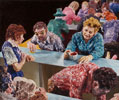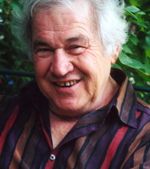Adolph Rosenblatt
Since I'm his wife, I've seen almost all of Adolph Rosenblatt's shows over the past 38 years. A lot of years, a lot of shows, I never tire of looking at the sculptures, and I never tire of watching the watchers. People are fascinated by his work, drawn in by the vibrant colors, the form, the content. And they are delighted; they always leave laughing, though they may find it difficult to say exactly why. Perhaps it's because the gallery full of sculptures seems like a room full of people they know, scaled down in size and caught in their everyday activities. The cup of coffee is on its way to the mouth, the child is modeling with clay (while Adolph is modeling her), a man is mowing the lawn, closing a window, reading the newspaper.
For that's what Adolph has been doing over the past thirty years, documenting life as it's lived in Milwaukee, in restaurants, movie houses, alleyways, gas stations. In some cases it's life as it WAS lived; the lunch counter at the Oriental Pharmacy with its conglomeration of characters survives in three-dimensional form now only in Adolph's sculpture. So does the Gay Garden, a Chinese restaurant formerly at the corner of Third and North. Trees are chopped down, buildings razed or renovated, people die, children grow up, but here they still are, almost alive before our eyes. And that's what makes these sculptures great: they ARE almost alive, done in a loose, energetic manner, sculpted from life, except for the ones based on the NEW YORK TIMES.

My Balcony |

Oriental Pharmacy Lunch Counter |
Adolph establishes a rapport with his subjects as he sculpts them, gets involved with their personalities and their problems, and somehow transmits this involvement to his work. Rather than worrying about a literal replication, he concentrates on capturing the essence.
Even when doing large sculptures like the Gay Garden or Imperial Motors, he doesn't worry about literal replication, doesn't worry that you can't see the interior and exterior simultaneously. He simply removes some wall.
Although his reliefs of the NEW YORK TIMES' front pages at pivotal moments in recent history aren't executed on the scene, they still have that energy and life because Adolph conveys his personal excitement about what was happening at the time. He takes the flat front pages and makes them three-dimensional, forces us to see even more powerfully the river of people flowing from East to West with the fall of the Berlin Wall.
From looking at Adolph's work, an observer would never suppose he studied at Yale with Josef Albers, the master of the square. But Albers was also a master of color, and he had a profound influence on Adolph. In fact Adolph's paintings immediately after art school were almost abstract, studies in color, not rigid but impressionistic, based on leaves and trees. He gradually became more figurative, painting New York City with palette knives instead of brushes, using brilliant colors directly out of the tubes. Eventually the paint became so thick he realized he no longer wanted to work in two dimensions; he wanted to sculpt. He began with beeswax, soft and malleable, almost like blobs of paint, and he did actually paint these wax sculptures.
Since we lived in New York, he sculpted large cityscapes, documenting life there much the way he now documents Milwaukee.
When we moved to Milwaukee in 1966, he was still working with wax, but then casting the pieces into bronze, the lost wax process. He used very thin sheets of wax so the resulting bronzes would weigh less, and thus the casting would cost less. Even in thin sheets, bronze was expensive, and Adolph was anxious to find an alternative medium. Our sons found one for him. They brought clay home from grammar school, and that started a new chapter in Adolph's career, a chapter which has lasted thus far for twenty-five years.
Suzanne Rosenblatt, 1996
[Rosenblatt Gallery]
[Portfolio] [Adolph at Work] [Photos of Adolph]
[Reviews] [Résumé] [Shows]
[Adolph's UWM home page]
Copyright © 2002-8 Suzanne Rosenblatt. All rights reserved.
[an error occurred while processing this directive]